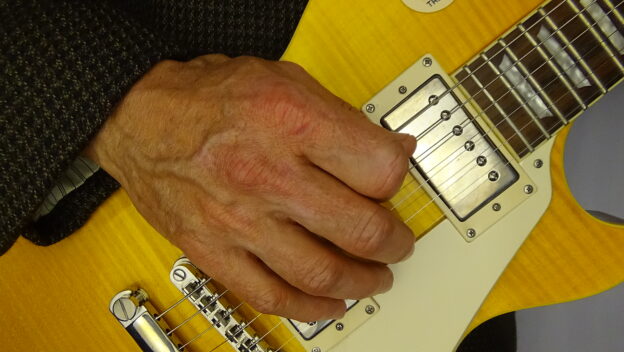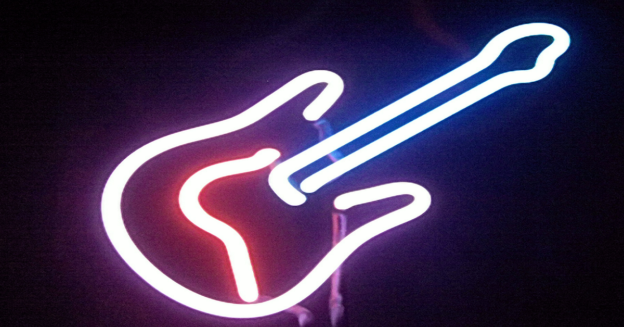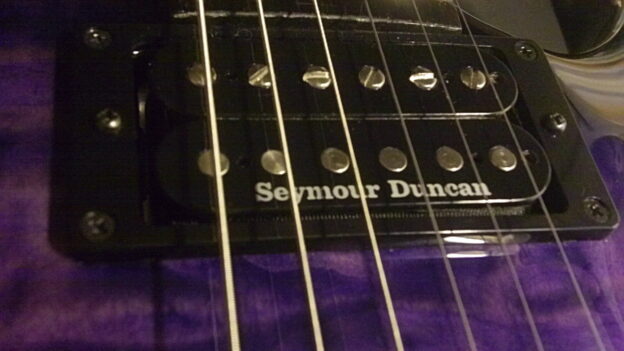Chad Crawford, PMI Blues Guitar Instructor
So you have an electric guitar now and maybe a small starter amp and you are starting to become aware of all these little extra boxes that some guitar players use. What is all this stuff? What does it do, and do you need it? Well, this could be a huge subject but I am going to cover only the basics. Once you understand the basics you can do a little more research on your own to decide what, if any, effects that you may wish to incorporate in your preferred tone. First, a little background information …
Definitions
Tone – At the root of all discussion of guitars, amp, and effects, is one core concept: Tone. You will see this term in all manner of advertisements for guitars, amps, and equipment, and you will hear it discussed and even argued among musicians. What does it mean? It has somewhat of a subtle meaning that will be hard to understand well until you develop a little skill on the guitar and begin to develop your discernment for sound quality. For the moment let’s try to understand it this way. Tone refers to the overall sound quality of your instrument. I do not mean quality in the sense of good or not so good, but rather quality in the sense of characteristics. For example you might say that wood has certain qualities and metal has certain qualities. Likewise, sound has different qualities and these qualities vary among different guitars, amps, and effects, and various combinations of the above. As you develop as a musician you will naturally gravitate toward a certain preferred quality of sound from your instrument. Musicians refer to this quality of sound as tone.
Pedal – a floor standing effect device usually actuated by a foot switch, leaving the rest of you free to work your guitar magic. Guitarists often install pedals in a Pedal Board, which is simply a suitcase specifically designed for mounting guitar pedals and associated wiring.
Rack Mount – the effect circuitry does not care if it is mounted in the floor, wall, ceiling, amp, or wherever you want. So some effects come in a convenient box that is designed to mount into a specific type of instrument electronics travel cabinet (rack). This allows for manipulation of the parameters of the effect without having to kneel to the floor. Rack effects are also more typically able to be controlled via “midi”, which allows for advance programming of various combinations of effects such that one can have preset effects combinations for each song, readily accessible either by foot control or else remotely by the sound engineer at the control board. Rack effects tend to be more sophisticated than their floor pedal counterparts.
Sensitivity – the ability of the guitar to sound out clear notes with minimal finger pressure and string striking power. This will depend largely on the guitar and amp, but some effects also affect sensitivity. Generally, more is better.
Sustain – the ability of the guitar to continue sounding out a note after it has been plucked. As with sensitivity, this will also depend largely on the guitar and amp. Some effects will affect sustain and in fact some effects are specifically to enhance sustain. As with sensitivity, more is generally better.
Utilities:
Some devices referred to as “effects” are not really so much effects but rather are more like utilities. This will make more sense as we discuss specific devices. So let’s dive into specific effects now. Keep in mind we are speaking in general terms. There are literally thousands of effect devices on the market with various combinations and qualities of various kinds of utilities and tone alterations. We will highlight the basic concepts here.
Noise Suppressor or Noise Gate – the purpose of a Noise Gate is not to alter tone but rather to remove noise, as the name implies. If you have had some opportunity to play around with your guitar and amp you may have noticed a hum from your amp when you are not playing the guitar. The purpose of the Noise Gate is to remove that hum or at least reduce it to a very low level. If you are new to guitar and mostly playing at bedroom volumes then the hum may not bother you so much. As your ear for music develops and you begin to gravitate toward higher volumes for live group performance, the hum will grow louder and more annoying! Then you will want a Noise Gate.
Volume – more of a utility than an effect, although you can use a volume pedal prior to the pre-amp to create a keyboard-like tone from your guitar (a.k.a swell). The main purpose, however, is to control the guitar volume without having to use your hands to manipulate knobs.
Tuner – an electronic device that provides a tuning reference for you to measure your guitar’s tuning against. It allows for very rapid and accurate tuning.
General Purpose Effects:
Echo – May also be called Reverb. This is a very common effect and many modern amps will have this effect built in. The echo or reverb effect is similar to the natural phenomenon of echo. It works like this: you play a note on your guitar. The echo processor will expand that as if you played it in a large room or cavern. This effect adds fullness to your tone, making it sound more natural and thick. Of course you can dial it in to an extreme that does not sound natural at all.
Delay – similar to echo, but delay is a more specific, narrow reproduction of the note you just plucked. Unlike natural echo, you control the volume level and timing of repeats, as well as the decay (attenuation level or loss of volume level) of the repeat notes. As with echo, this effect adds fullness to your tone, making it sound more natural and thick. And again you can dial it in to an extreme that does not sound natural at all.
Expression – this effect is often referred to as Wah, Wah Wah, or Crybaby. It is typically a pedal that you oscillate with your foot to move an internal tone control through a range from very pronounced high/mids to very diminished high/mids. It will also alter your overall tone. You may also see it in the form of a device that automatically cycles throughout a preset tone range without oscillating foot pedal input.
Distortion – Distortion is the characteristic electronic fuzz sound associated with electric guitars. There are different levels of distortion and different types of distortion that yield different overall guitar tones. Most modern amps will include a distortion effect by design, often referred to as Drive, Overdrive, or Gain. Additionally, you can usually achieve a certain natural distortion by over powering your amp speaker(s) at high volume levels. A distortion pedal can enhance tone, sensitivity, and sustain at lower volume levels. Choosing a distortion pedal can get complicated because this is very much a matter of personal preference. Also, the different types and degrees of distortion have trade names, such as crunch (mild distortion), overdrive (substantial distortion), and fuzz (extreme distortion). Beyond this, the brand names of distortion pedals, like the popular Tube Screamer, may not indicate distortion at all. You will often see distortion pedals referred to as a Stomp Box.
Compressor – the purpose of a compressor is to raise low volume signals and suppress high volume signals. The intent is to level out the harshness of extreme variation in volume levels. Because it raises the power level of lower volume or weaker signals, it will also enhance sustain.
Modulation – this effect comes in a variety of forms and goes by different trade names even though it is all the same underlying effect. You may see it identified as Flange, Chorus, Phaser, Rotary Horn, Tremolo, or Uni-Vibe. The basic idea is to impose a varying frequency signal over your guitar signal, creating a wobbling sound. As with other effects, you control the rate and degree of the wobbling. The various names indicate different types or tonal qualities of the effect.
Many vendors have floor controllers or rack-mount controllers that incorporate some or all of these effects and more all in one box, such as the POD products by Line6.
Now that you know the terminology, you may be wishing you had some sounds to associate with these names. You can easily find demonstrations on various vendor sites such as MusiciansFriend or Sweetwater, or video hosting sites such as YouTube. Alternatively, if you’re willing to invest around a hundred twenty dollars for an entry level converter box (interface) such as the Focusrite Scarlett solo, along with another hundred for an entry level guitar simulator program such as Amplitube or Bias FX, then you can experiment with a variety of guitar effects with a simple click of the mouse.
Hardware or software, experiment and enjoy!
Copyright © 2005 Palmetto Music Institute. All Rights Reserved.



